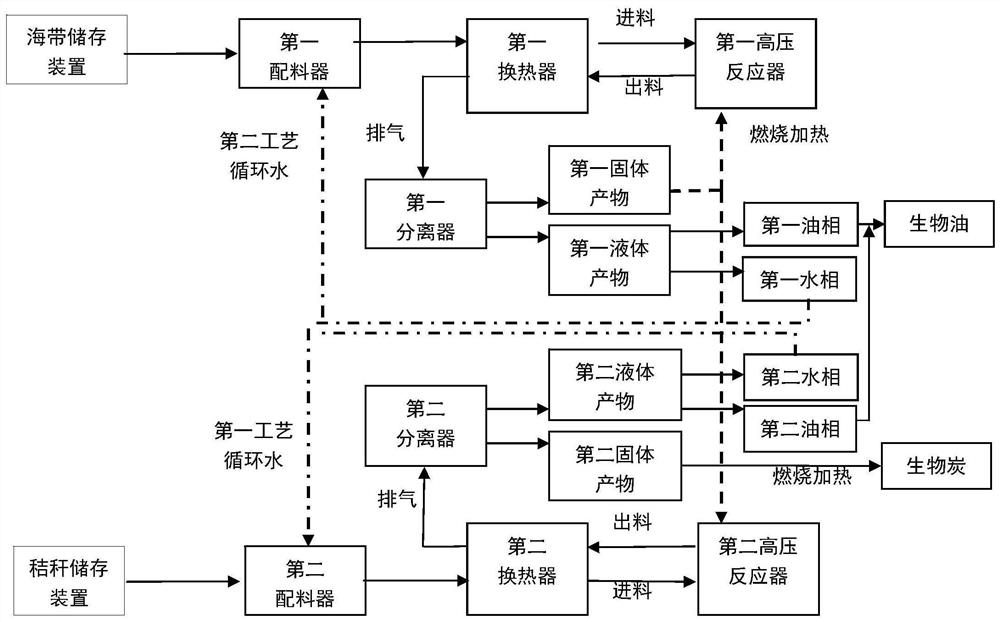A method and device for combined treatment of kelp and straw
A combined treatment and straw technology, which is applied to the preparation of hydrocarbon oil, liquid hydrocarbon mixture, waste fuel, etc., can solve the problem of high energy consumption, and achieve the effects of promoting straw conversion, efficient conversion and utilization, and reducing wastewater discharge
- Summary
- Abstract
- Description
- Claims
- Application Information
AI Technical Summary
Problems solved by technology
Method used
Image
Examples
Embodiment 1
[0044] 5 grams of fresh kelp raw material (water content 82%) was added to 10 grams of corn stalk carbonized water phase circulating water, and then sent to the reactor after heat exchange in a heat exchanger. The reactor was heated to 280 degrees Celsius and reacted for 30 minutes. The product was subjected to heat exchange in a heat exchanger and was further cooled to 70 degrees Celsius. The product gas was discharged. The remaining products were separated from solid and liquid to obtain 0.135 g of solid product. .
[0045] 3 grams of corn stalk raw material (water content 22%), add 14.43 grams of kelp liquefied water phase circulating water, exchange heat through a heat exchanger, send it to the reactor and heat it up to 230 degrees Celsius, react for 90 minutes, and the product is heat exchanged through the heat exchanger The temperature was lowered to 70 degrees Celsius, the product gas was discharged, and the remaining products were subjected to solid-liquid separation t...
Embodiment 2
[0048] 10 grams of fresh kelp raw material (water content 82%) was added into 20 grams of corn stalk carbonized water phase circulating water, and then sent to the reactor after heat exchange in a heat exchanger. The reactor was heated to 280 degrees Celsius and reacted for 30 minutes. The product was subjected to heat exchange in a heat exchanger and further cooled to 70 degrees Celsius, the product gas was discharged, and the remaining products were subjected to solid-liquid separation to obtain 0.261 g of a solid product. .
[0049] 3 grams of corn stalk raw material (water content 22%), add 28.812 grams of kelp liquefied aqueous phase circulating water, exchange heat through a heat exchanger, send it to the reactor and heat it up to 230 degrees Celsius, react for 90 minutes, and the product is heat exchanged through the heat exchanger The temperature was lowered to 70 degrees Celsius, the product gas was discharged, and the remaining products were subjected to solid-liquid...
Embodiment 3
[0052] 10 grams of fresh kelp raw material (water content 82%) was added to 20 grams of corn stalk carbonized water phase circulating water, and then sent to the reactor after heat exchange in a heat exchanger. The reactor was heated to 340 degrees Celsius and reacted for 20 minutes. The product was subjected to heat exchange in a heat exchanger and further cooled to 70 degrees Celsius, the product gas was discharged, and the remaining products were subjected to solid-liquid separation to obtain 0.288 g of a solid product. .
[0053] 3 grams of corn stalk raw material (water content 22%), add 28.722 grams of kelp liquefied aqueous phase circulating water, exchange heat through a heat exchanger, send it to the reactor and heat it up to 230 degrees Celsius, react for 90 minutes, and the product is heat exchanged through the heat exchanger The temperature was lowered to 70 degrees Celsius, the product gas was discharged, and the remaining products were subjected to solid-liquid s...
PUM
| Property | Measurement | Unit |
|---|---|---|
| heating value | aaaaa | aaaaa |
Abstract
Description
Claims
Application Information
 Login to View More
Login to View More - R&D
- Intellectual Property
- Life Sciences
- Materials
- Tech Scout
- Unparalleled Data Quality
- Higher Quality Content
- 60% Fewer Hallucinations
Browse by: Latest US Patents, China's latest patents, Technical Efficacy Thesaurus, Application Domain, Technology Topic, Popular Technical Reports.
© 2025 PatSnap. All rights reserved.Legal|Privacy policy|Modern Slavery Act Transparency Statement|Sitemap|About US| Contact US: help@patsnap.com

